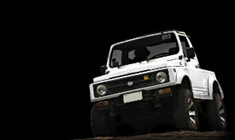News
My 2018 Aprilia RSV4 RF: Purchase & ownership experience
There was a power above 4,000 rpm and it just built up in a very linear fashion all the way up. The brakes were phenomenal and so was the handling.
BHPian vignesh.cv recently shared this with other enthusiasts.
Introduction
Motorcycles have always fascinated me. The feeling of freedom and the raw experience is something that is hard to describe in words. Got exposed to GP and WSBK in 1990 when cable TV was available for the first time in my home. Watching the way the professionals wield their machines into doing impossible things was just like magic. And that’s when the desire was born, the desire to ride a motorcycle on the race track. The desire to experience a superbike - I didn’t know the definition of it back then, just knew it had to be a good setup, powerful machine. Soon after, college finished and the job hunt and settling on the first job all meant this desire took a back seat. There was no means to fulfil the desire and it stayed that way for a very long time. Until 2010. That’s when a good friend of mine announced he’s letting go of his 2006 Honda CBR 600RR. I spent a lot of time thinking about the pros and cons and finally decided to take the plunge. Little did I know that it would transform my motorcycling experience for good from that point onwards.
Past
Goldspot 2010 - 2018
I called the 600RR Goldspot - the pearlescent orange colour was beautiful to look at, especially in sunlight and the bike drew a lot of attention whenever I took her. I graduated from a Yamaha RXZ to this and it was like a quantum leap in terms of everything. She taught me what it means to ride a supersport bike - the handling, braking and power delivery was just crazy. I got introduced to handling, suspension setup, tyres, fuelling and a whole bunch of things. She was very forgiving and always had more on offer. I’ll perhaps start a separate thread about her later.
Thunder 2018 -
Purchase experience
Aprilia is a brand name I recollect from the days of watching 250 GP races - especially the Chesterfield Aprilia of Max Biaggi. It always seemed to have that edge in terms of power, handling over other rival factories. Aprilia launched their first 4 cylinders superbike in 2009 named the RSV4. I still have copies of print magazines carrying the review of the bike. For me it was love at first sight. The proportions, the V4 motor, the chassis all of it bowled me over. It was the first production bike to include a huge amount of adjustability built into the chassis. Initially, only the Factory model had all those provisions, but later on, the base version also carried those.
Do you need a bike that is more stable all through?
No problem, just keep the engine mounted at the lowest of the positions and you are good to go.
Do you need a bike that is more agile and needs to flip into corners quickly?
No problem, just keep the engine mounted at the highest of the positions and you are good to go.
Do you need a bike that is lazier in terms of steering?
Do you need a bike that is sharper in terms of steering?
No problem, just change the headstock bushings to a different offset and you are good to go.
Do you need to change the swing arm angle?
No problem, just get the correct pivot plate and you are good to go.
None of the production bikes to date offers such kind of adjustability in the base chassis.
And then in 2011, they updated the package with the aPRC package a.k.a Aprilia Performance Ride Control which brought in Traction Control, Wheelie Control, Launch Control, ABS and a 6-axis IMU providing the necessary input. This was revolutionary back then as the other competing systems were more rpm based and did not offer a smooth riding experience. They had also entered WSBK by now and roped in the services of one of their best riders from the past - Max Biaggi. Biaggi won 2 world championships against stiff competition and chose to retire in 2012. The 2 world championships further cemented Aprilia’s RSV4 as a worthy contender in both production and superbike classes.
Moving onto 2015, Aprilia bumped up the power output to a claimed 201hp at the crank and refined their electronics package even more. All the goodness of the original package was retained and it was more like an evolution.
In 2017, Aprilia further refined the package by changing the geometry and electronics making it an even more potent package. The engine was still under 1000cc though.
I was on the lookout for the Aprilia but wasn’t too sure of the ownership experience in India. That’s when I came in touch with Manjunath who owned a 2013 RSV4 Factory during one of the track days. He graciously allowed me to take a few laps on his bike. That experience sealed the decision for me. The handling, the seamless power delivery, phenomenal brakes did it for me. The only bike I wanted was the Aprilia, nothing else. Yes, there were other litre-class bikes that were less expensive, claimed more features etc., but none connected to the soul as the Aprilia.
Moving to 2018, my friend Manjunath introduced me to Mr Shreekant Apte, who runs Arco Automotive - dealing with Piaggio commercial vehicles and Aprilia / Moto Guzzi range of motorcycles based out of Pune. That was another turning moment for me. I met someone who was passionate about automobiles and motorcycles. We spoke about the availability, servicing and then finally the cost. I decided my mind and then spoke with the CEO for final approval.
I made the token advance payment and the order was placed. The ex-showroom price was 20.8L for the RF / Factory version. The bike reached me in about 40 days. The PDI check and verification was all done prior to shipping it via road to me.
Features
The bike is really a superbike racer disguised as a street-going motorcycle. The chassis has provision to adjust the mounting position of the motor in one of the three possible positions.
Engine
Aprilia came up with a narrow V4 engine as a successor to their V-twin Aprilia Mille. That was the time when WSBK was transitioning from 750cc 4 cyl / 1000cc 2 cyl into 1000cc 4 cyl / 1200cc 2 cyl configurations. The engine features a 65deg V angle and is designed to be very compact. The engine was designed with participation in WSBK in mind and therefore featured enough headroom to squeeze out 220+ hp right from the initial design.
Coming to a V4 design, the general consensus is that having a 90-degree angle provides the perfect balance, but that also means there are some compromises to be made in terms of the overall packaging. Aprilia went with a narrow design to provide a more compact motorcycle and therefore chose a different set of trade-offs.
The motor produces a claimed 201 hp at the crank and was also EU4 compatible. The motor revs to *only* 14,000 rpms but max power is produced at 13,000rpms. There is no point in redlining the motor, rather use the liberal torque that is produced from mid-top to your advantage.
Even though the motor produces a claimed 200hp, it doesn’t feel mental. Rather, the power comes in a very linear fashion, allowing you to take complete advantage of the mechanical grip offered by the package and thereby making the ride very effortless.
The throttle is completely RBW (Ride by Wire) and that means there are 3 riding modes on offer.
- Sport - offers a more direct throttle connection and offers max engine braking
- Track - offers slightly softer throttle response compared to Sport and reduced engine braking
- Race - offers gentle throttle response in the lower gears with minimum engine braking
The modes can be changed on the fly by holding the starter button for a second.
I tried the Sport / Track initially on the track and eventually settled to the Race mode as I preferred the reduced engine braking and softer throttle response when riding on the track.
Chassis
Engine mounting
- Lowest - places the engine low in the frame and thereby lowers the CoG giving a very planted and stable experience.
- Middle - places the engine in the middle / zero position. Gives a good balance between stability and agility. The Tuono used to come with this position by default.
- Highest - places the engine high in the frame and thereby raises the CoG. This has the effect of making the bike fall into corners swiftly.
Swingarm pivot
In addition to that, the swingarm pivot also can be placed higher or lower depending on the riding preference. Three possible mounting points are provided.
Headstock
The steering rake & trail can also be adjusted by varying the steering head bush to achieve the right kind of offset. Rake and trail have a significant impact on the way the bike falls into the corners and how stable the front end feels under acceleration.
The bike and chassis are designed to give the rider maximum mechanical grip which is very much noticeable when you ride her on slicks. More on that later.
Suspension
The factory variant comes with Öhlins suspension for both front and rear. The front is the regular cartridge and the rear is a TTX shock. Both are adjustable for preload, compression, rebound and ride height. The manual comes with the recommended settings for road and track riding including compression, rebound and rides height numbers. The steering damper is made by Öhlins as well.
Electronics
Aprilia was the first brand to introduce a IMU-based traction control in the production category via their aPRC package. They’ve been refining it constantly over the years and in the 17-18 years, they placed the IMU in a different location in order to make it more sensitive. The standard feature of the aPRC includes
- aTC - Aprilia Traction Control adjustable in 8 steps. 1 being lowest and 8 being the highest level of intrusion by the ECU. The bike uses a combination of comparing front & rear wheel speeds as well the IMU and a bunch of other parameters to decide on the intervention required. Can be completely turned off for the brave hearts among us. The handlebar offers a paddle adjuster to increase or decrease the TC level on the fly.
- aWC - Aprilia Wheelie Control adjustable in 3 steps. 1 being the lowest and 3 being the highest level of intrusion by the ECU. This basically decides how much your front wheel will rise on hard acceleration. Can be completely turned off separately and while keeping the TC active. Some of the other manufacturers had tied up TC & WC and therefore turning off one would disable the other as well. There is a dedicated button on the left handlebar to adjust the wheelie control on the fly.
- aLC - Aprilia Launch Control adjustable in 3 steps. 1 being lowest and 3 being highest in terms of control/slip. This is useful when you are in the starting grid and want to get that perfect launch off the grid. I’ve not tried this feature yet.
- aQS - Aprilia Quick Shift. Offers clutchless quick shifts for both upshift and downshift (auto-blipper). I chose to keep the feature on as it is such a joy to use it, especially on the race track.
- ABS - Since 2017, Aprilia started offering Race ABS as standard with cornering multi-map offering three levels of safety
- Track - offers minimal intrusion, active only on the front wheel. Rear-wheel lift mitigation is disabled as is the cornering intrusion.
- Sport - for sport/amateur track riding purposes. The ABS is active on both wheels and offers Rear wheel lift mitigation ( adjusts front brake and applies rear brake when it senses the rear wheel lifts up under hard braking) as well as cornering ability.
- Rain - as the name implies, offers max stability under low grip conditions. Both rear-wheel lift mitigation and cornering ABS is fully active.
ABS can be turned off completely and can be permanently deactivated via the dedicated Race ECU mapping from Aprilia.
In addition to these, there is also a connectivity package called Aprilia V4MP or Multimedia Platform available on the factory variant. It allows one to pair their smartphone via Bluetooth and thereby receive calls, play music - I honestly don’t know who would have the mental space to make and receive calls on the go on a 200hp superbike. The V4MP also offered a very important feature - to actually perform data logging of the various parameters like rpm, gear, throttle %, brake pressure, wheel slip and few more parameters on the phone, in addition to configuring what Aprilia calls as “turn by turn configuration” of the electronic parameters like aTC and aWC based on where you are in the race track. So, if you are coming up a corner that is more shallow and you’d like to run more throttle, you can configure the app to reduce aTC level only for that corner and switch to the default value for the other parts of the track.
Initial ride impressions
I rode the initial 1000 km on the road to break in the motor and took it easy. The initial impression was that the bike felt no larger than my Honda. I was able to find a comfortable riding posture. The motor had loads of torque in the low end which was a stark comparison to the 600RR that came alive after 8k RPMs. There was a power above 4k RPMs, and it just built up in a very linear fashion all the way up. The brakes were phenomenal and so was the handling. Since I moved from an analogue bike, I had a long way to go in terms of getting used to the electronics and most importantly learning to trust the electronics.
The first service was done at the 1000 km mark - Sumit was visiting Bangalore and a few owners combined the servicing and thereby split the travel costs. Oil was changed along with the filter. Sumit also ran the diagnostics to check for errors/malfunctions. Finally, he adjusted the chain and lubricated it. I went with Liqui Moly Street Race 5w40 fully synthetic oil.
Track riding impressions
I did my first track day in 2019 as part of the IndiMotard TWO school. The bike was so easy to ride on the track and I did not have to put in a lot of effort. It is only when I did the back to back left / right-handers, did I feel the weight of the bike. I had to physically steer the bike to make it fall into corners. But on the back straights, the bike was super stable and was very reassuring. I rode on the stock Pirelli SuperCorsa SP tyres with the aTC level set to 5. I initially tried the Sport map and found the engine braking a bit too much to my liking. The throttle connection was instantaneous which I enjoyed initially.
My biggest revelation was while powering out C7 at the MMRT track - it is a very long right-hander that needs you to have bike placement & good vision skills to nail it perfectly. I noticed that I was able to carry a lot more throttle through the corner than my 600 and I attribute that primarily to the pure mechanical grip offered by the chassis.
I tried to get used to the ABS intervention by trying to do a few hard braking on the back straights. I first tried with ABS level 2 and found that to be comfortable. The intervention was very minimal and it did not change my braking distance in any significant way.
What I noticed though was due to the stock ergonomics, my left hand had the tendency to increase the TC levels sometimes and in one session as I was coming out of C2, I felt there wasn’t the usual drive out of the corner. I saw the lights flashing on the console indicating the electronics intervention and noticed the TC level had become 8. The other aspect with the stock ergonomics was that I had to consciously ride by positioning myself towards the seat bump stop. Otherwise, the inner portion of my thighs would come in contact with the curved part of the fuel tank and that made for a painful experience.
Otherwise, the ride was stress-free and the bike had a lot more to offer. I had to finish my session only due to my lack of fitness and stamina and not because of the bike.
The tyres were super sensitive to air pressure and suspension settings, especially the rear. After some trial and error and help from fellow riders, I adjusted the rebound for the rear shock to clear up the cold tears happening on the tyre.
I connected my smartphone and used that to record lap times and perform data logging for one of the sessions. Since MMRT was not a listed track in the app, I had to create a custom track and then do the data logging. This worked really well and it was cool to pore over the data captured later on.
Modifications
Ergonomics
As I mentioned earlier, I found the stock egos to be a bit cramped for my height. I did some research and asked around in some places and understood that the handlebars and foot position need to be positioned differently. The stock handlebars were a bit high and angled towards the rider, the stock footrest was positioned slightly higher as well.
I went with Spider Racing’s handlebars, which had zero rises (which meant I have to crouch a bit more) and allowed me to position the bars a bit away from me giving me the space for my arms and giving me much needed leverage to flip the bike in chicane type of corners.
For the footrest, I went with GiaMoto rear sets. They are more like jewellery with precise craft and finishing. The best part was, they allow me to use the stock rear brake light switch - more aftermarket rearsets force you to purchase a hydraulic switch to activate the stock rear brake light. Another difference with GiaMoto was they offer a “comfort kit” - this positions the footrest a couple of inches lower and that gives much-needed comfort for taller riders.
I also swapped out the OE top triple clamp to one made by Melotti Racing - this helps transmit more feel from the front end and helps a tiny bit in that regard. It also saves a few hundred grams when compared to the OE unit.
Performance
Since I was going to be riding the bike on the track only, I decided to do change the following areas:
- Air filter
- Exhaust
- ECU mapping
I went with Sprint Filter’s P08 F1-85 air filter - they are made in polyester material and can be cleaned easily with just compressed air. Since the material is polyester, they do not need oiling as well. They claim a much higher flow of air than conventional cotton/fabric type filters.
For the exhaust, I did a lot of research and then finally decided to go with Aprilia’s recommendation of Akrapovic full system exhaust. The header diameter is the same as the stock unit, and it also has a balance pipe between the front and rear bank of headers. This eliminates the exhaust servo as well. Aprilia sells a specific mapping for the ECU for this exhaust (also known as the Aprilia RACE ECU mapping). One can either buy a pre-flashed ECU from Aprilia (or) flash their stock ECU with this mapping. I went with the latter option.
Since the exhaust servo unit was eliminated, I decided to remove the servo motor as well. That sits beside the oil filter on the right side of the engine. The cables, motor etc come off completely. I also took this opportunity to disconnect the secondary air injection mechanism - this consists of a solenoid and rubber hoses that connect to the airbox and the front and rear bank of exhaust ports. It helps burn out excess fuel in the exhaust by injecting fresh air which is drawn from the airbox. Cleaning that up also saved a little bit of weight and most importantly freed up much-needed space in the cylinder heads.
There is also a petrol vapour recovery system - which is nothing but a charcoal canister that takes in fumes from the fuel tank and connects it back to the airbox. I removed that as well. The canister sits on the left side of the engine behind the radiator and removing that helped bring down the temperatures by a good margin.
Track-specific
To help with lap time measurement and data logging from the ECU directly, I got the AIM Solo DL unit. This unit uses GPS positioning to give you accurate GPS speed and lap times. It can also log data from your ECU to capture stuff like Throttle %, brake pressure, lean angle, gear position, TC intervention, wheel slip etc.,
This means you can now overlay all of this information on top of the track layout to get an understanding of how you are performing lap by lap. As you pick up the pace and want to improve further, looking at data can be an invaluable tool and this investment has been very valuable for me.
In order to data log from ECU, one has to prepare a Y cable which will split the data flowing from the ECU to the dashboard into two - one which can go to the dashboard as usual, and the other to the AIM unit. There is no cutting or splicing of wires here, as the connectors are standard and it is very easy to fabricate them. I ended up going this route and took help from Anand of IndiMotard Greasehouse to do the installation.
Verdict
In my personal opinion, if you are looking for a machine that is used primarily on the race track, then this has to be one of the contenders. Sure, the Ducati V4S putting out crazy power, the BMW with its new S1000RR has fancy variable valve timing and boasts fancier electronics, the Kawasaki ZX-10R and ZX-10RR with mouth-watering pricing and WSBK pedigree, the Yamaha R1 with its sweet-sounding cross-plane engine and its own cult following and Honda with its never-ending RRRR Fireblade, but one ride on the Aprilia RSV4 will tell you how much the chassis talks to you out of the box, how creamy and smooth the power delivery is and how you can trust the front end with your life and she'll continue to reward you with such a stress-free and effortless way to reel in those lap times. That to me is a feeling that's not yet beaten by any other manufacturer to date. Until then, it is the Aprilia RSV4 for me.
Note: For those looking at hp numbers, the new Aprilia RSV4 1100 Factory offers 217hp out of the box and promises even more electric motor like torque and handling and refinement.
Warning: there are lots of pictures, I've linked them to Flickr so it shouldn't be too much of a load for Teambhp.
Getting the bike delivered



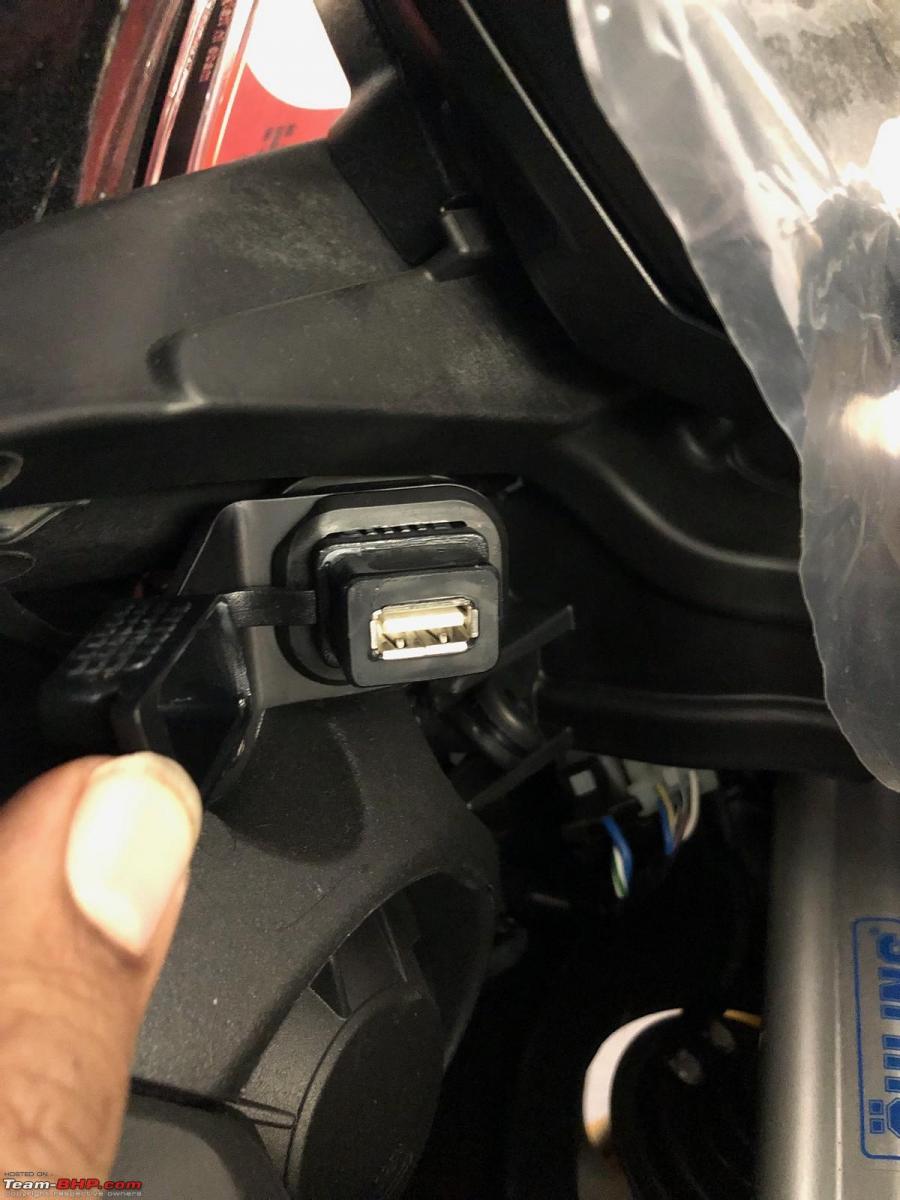
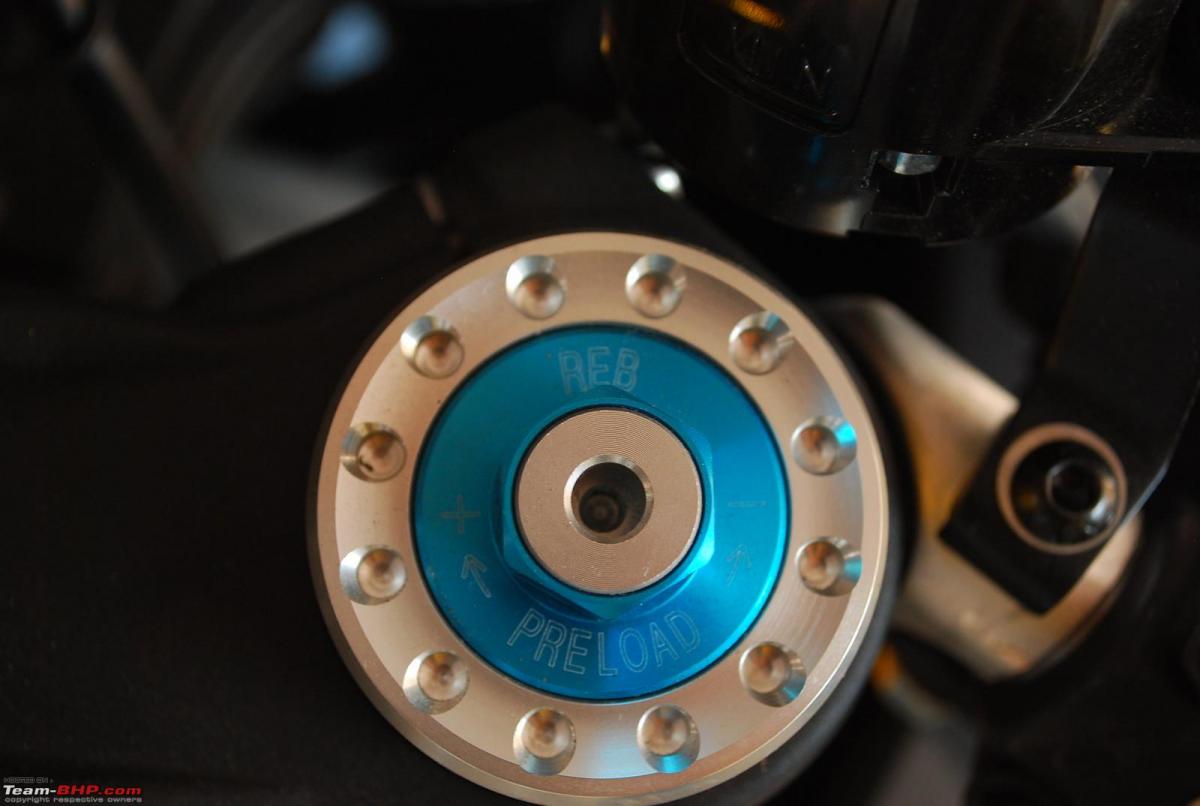


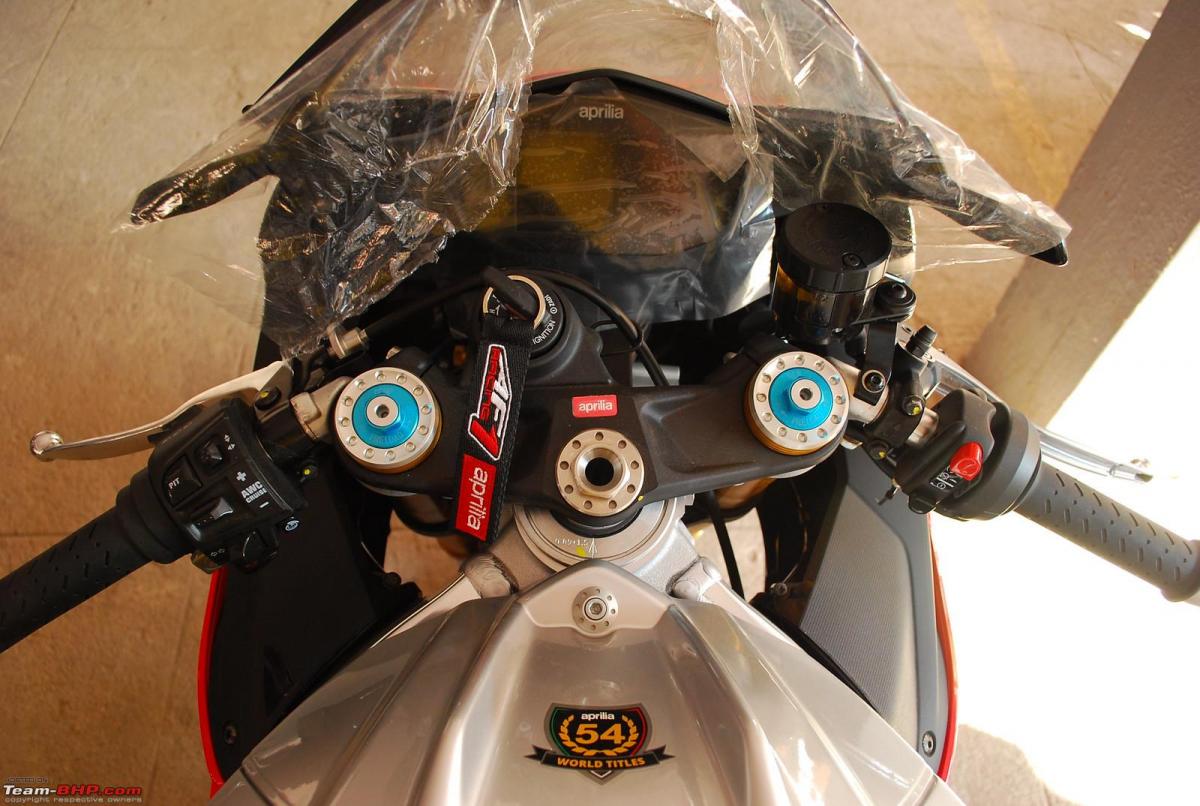










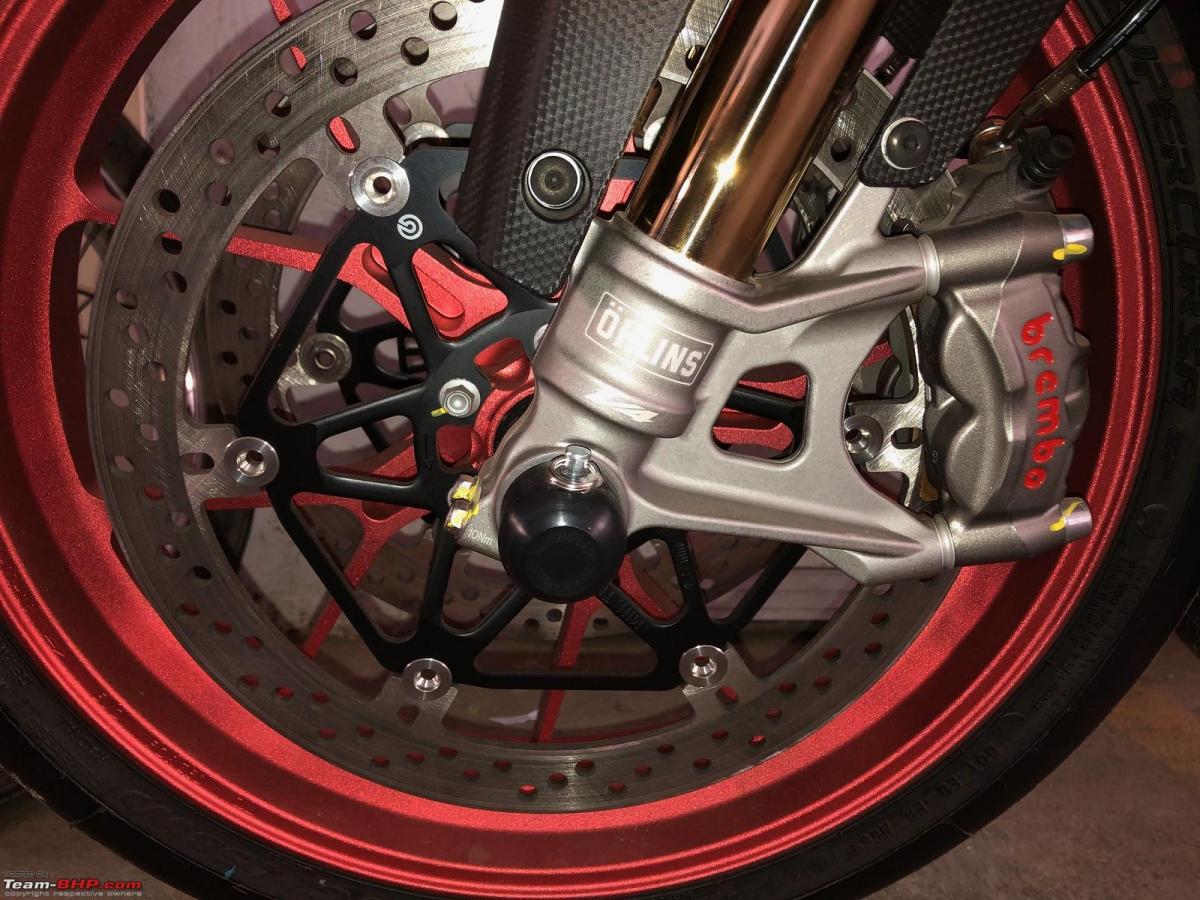


Check out BHPian comments for more insights and information.














.jpg)

